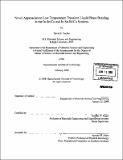Novel approaches to low temperature transient liquid phase bonding in the In-Sn/Cu and In-Sn-Bi/Cu systems
Author(s)
Fischer, David S., Ph. D. Massachusetts Institute of Technology
DownloadFull printable version (39.57Mb)
Other Contributors
Massachusetts Institute of Technology. Dept. of Materials Science and Engineering.
Advisor
Thomas W. Eagar.
Terms of use
Metadata
Show full item recordAbstract
A fluxless low temperature transient liquid phase (LTTLP) bonding process was studied as a method of producing Cu/Cu joints below 125°C and 75°C using interlayer alloys from the In-Sn and In-Sn-Bi systems. Using thermodynamic models, three different compositions (wt. %) of base alloys were chosen to accomplish this task: 50In-43.6Sn-6.4Bi (Tm = 110°C) and eutectic 50.9In-49.1Sn (Tm = 120°C) alloys were used for bonding at 125°C and a eutectic 48.3In-15.6Sn-36.1Bi (Tm = 60°C) alloy was used for bonding at 75°C. In addition, novel approaches to TLP bonding, including the addition of base material to the interlayer alloy and application of an electroless Ni diffusion barrier layer, were employed in an attempt to optimize this joining method. The LTTLP processes were assessed based on their abilities to produce joints with minimal thickness, high reflow temperatures, and good mechanical properties at room/elevated temperatures. It was found that interlayer alloys containing higher Bi contents produced the thinnest joints, with the 48.3In-15.6Sn-36.1Bi alloy producing joints on the order of 10 gm. Increases in nominal Cu composition of the interlayer alloy tended to form larger joints. Application of the Ni layer was observed to decrease the growth rate of the eutectic In-Sn joints made with 5 wt % Cu additions. Shear tests were performed on the joints at room (25°C) and operating (service) temperatures (100°C). Most of the TLP joints had room temperature shear strengths around 13,000 - 17,000 psi (= 90 - 120 MPa), although increases in strength were observed for eutectic In-Sn joints with 2.5 and 5 wt% Cu additions. At operating temperature, TLP joints made within the In-Sn-Cu system were found to have strengths an order of magnitude higher than those made in the In-Sn-Bi-Cu system. (cont.) Poor mechanical response of the Bicontaining joints was due to the presence of low melting In-Bi IPs present in the reaction zone. Eutectic In-Sn TLP joints made with 2.5 and 5 wt% Cu additions were found to have operational temperature shear strengths of 6,000 - 7,500 psi ( 40 - 50 MPa) and 7,500 - 9,500 psi (= 50 65 MPa), respectively.
Description
Thesis (S.M.)--Massachusetts Institute of Technology, Dept. of Materials Science and Engineering, 2008. Vita. Includes bibliographical references (leaves 112-113).
Date issued
2008Department
Massachusetts Institute of Technology. Department of Materials Science and EngineeringPublisher
Massachusetts Institute of Technology
Keywords
Materials Science and Engineering.